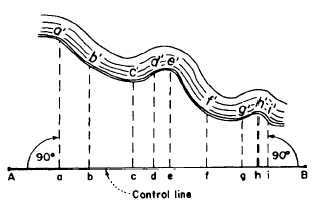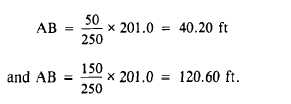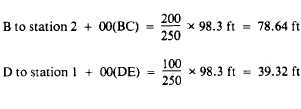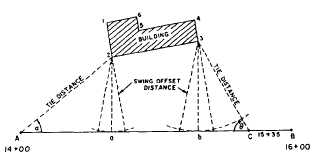0 + 00 and 2 + 50. The distances AB and AD can
be computed by ratio and proportion, as follows:
These distances are laid off on the random line
from point A toward station 0 + 00. The
instrumentman then occupies points B and D;
turns the same angle, 108°00´, that he measured
at point A; and establishes points C and E on lines
from points B and D through the stations being
sought. The dist antes are computed by similar
triangles as follows:
TYING IN A POINT
Determining the horizontal location of a point
or points with reference to a station, or two
stations, on a traverse line is commonly termed
TYING IN THE POINT. Various methods used
in the process are presented in the next several
paragraphs.
Locating Points by Swing Offsets
The SWING OFFSET is used
points close to the control lines
for locating
(fig. 13-21).
Measurement of a swing offset distance provides
an accurate determination of the perpendicular
Figure 13-21.-Swing offset method of locating points.
Figure 13-22.-Perpendicular offsets.
distance from the control line to the point being
located. The swing offset is somewhat similar to
the range tie (explained later), but as a rule,
requires no angle measurement. To determine the
swing offset distance, a chainman holds the zero
mark of the tape at a corner of the structure while
another chainman swings an arc with the
graduated end of the tape at the transit line AB.
When the shortest reading on the graduated end
of the tape is observed, the swing offset or perpen-
dicular distance to the control line is obtained at
points a or b. In addition, the horizontal distances
between the instrument stations (A and B) and
the swing offset points (a and b) maybe measured
and marked. A tie distance and angle a or @ may
be measured from either instrument station to the
corner of the structure to serve as a check.
Locating Points by Perpendicular Offsets
The method of PERPENDICULAR OFF-
SETS from a control line (fig. 13-22) is similar
to swing offsets. This method is more suitable
than the swing offset method for locating details
of irregular objects, such as stream banks and
winding roads. The control line is established close
to the irregular line to be located, and perpen-
dicular offsets, aa´, bb´, cc´, and so on, are
measured to define the irregular shape. When the
offset distances are short, the 90° angles are
usually estimated; but when the distances are
several hundred feet long, the angles should be
laid off with an instrument. The distances to the
offset points from a to i are measured along the
control line.
Locating Points by Range Ties
A point’s location can also be determined by
means of a RANGE TIE, using an angle and a
13-18








